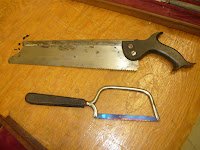The eyes are made of glass and the ears and tusks are made of leather. This one is missing a tail. It's painted gray with a red mouth, and you can see from the wear that this toy was well played with once upon a time.

Being made of wood, it's a very solid toy and weighs about 1lb. This is a toy made to last.
 The legs and head are detached, being connected to the body by a sturdy cotton cord. This makes it possible to move them so the elephant can be poseable. The legs are spool style.
The legs and head are detached, being connected to the body by a sturdy cotton cord. This makes it possible to move them so the elephant can be poseable. The legs are spool style.
Albert Schoenhut was a toy maker from Germany who came to
Philadelphia in the late 1800s. He
worked at a department store called Wanamaker’s making toy pianos. He used metal bars in the toy pianos instead
of glass ones, which really improved the sound.
Eventually, he left the store and opened his own toy manufacturing
company. Starting with making many
different types of toy pianos, he eventually started making the Humpty Dumpty
Circus. This became one of his most popular products and was exported around
the world. An advertisement of his
circus is seen here.
Christmas is coming and what would it be without toys. Our collection includes a Schoenhut
elephant! These toys were really popular
during their time, but, in the Great Depression, not many had money to buy toys
and eventually his company declared bankruptcy. Wouldn't it be great to have the entire circus collection?



















































